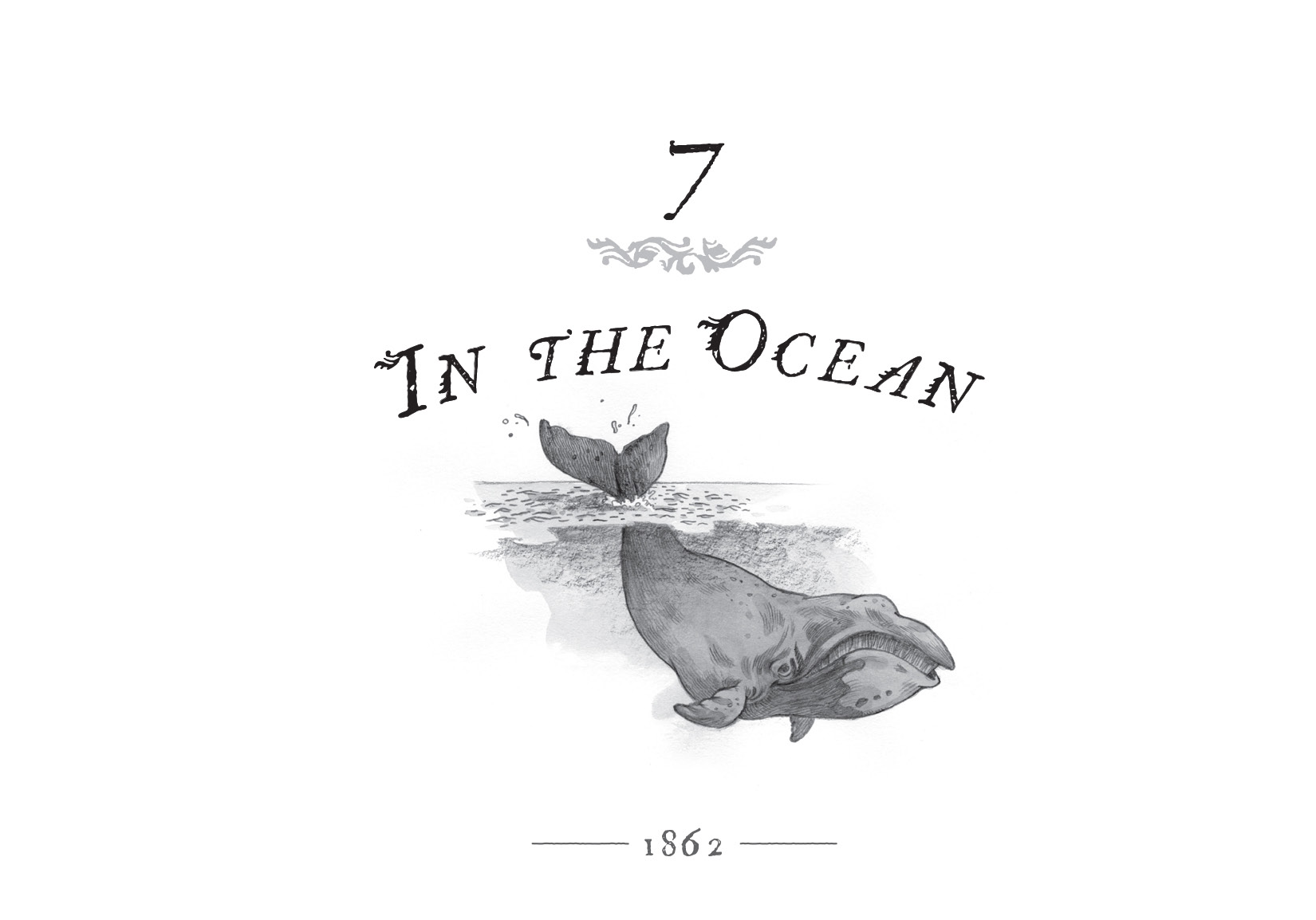Ice Whale (6 page)
Authors: Jean Craighead George

 joined a group of male bowheads on their
joined a group of male bowheads on their
spring migration. His mother had gone ahead with the other adult females. Their babiesâ born during the migrationâ swam beside them. The mother whales slowed their swimming speed to the calves' pace.
 was now thirteen years old and had left his mother's company long ago. Siku's mother was escorting a nursing daughter and teaching her about killer whales and whaling ships. The ships were following them along coastal currents to their summer home. There were hundreds of them.
was now thirteen years old and had left his mother's company long ago. Siku's mother was escorting a nursing daughter and teaching her about killer whales and whaling ships. The ships were following them along coastal currents to their summer home. There were hundreds of them.
 swam more rapidly than he ever had before to escape the ships. Near Barrowâ he swam along the Barrow Canyonâ which was scattered with brittlestarsâ anemonesâ and snow crabs.
swam more rapidly than he ever had before to escape the ships. Near Barrowâ he swam along the Barrow Canyonâ which was scattered with brittlestarsâ anemonesâ and snow crabs.
Fish swam by in large schools. Masses of clams opened and closed their shells. The seafloor seemed to move as they crawled from one place to another.
 had seen few walrus during his lifetime. Whalers had killed over three hundred thousand of them. The ocean life had changed markedly in the thirteen years of Yankee whale and walrus hunting. Siku could feel the change.
had seen few walrus during his lifetime. Whalers had killed over three hundred thousand of them. The ocean life had changed markedly in the thirteen years of Yankee whale and walrus hunting. Siku could feel the change.
Beyond Barrow, 's group joined another small group of male bowheads and crossed into the Beaufort Sea. This group had avoided the whalers by following an old and wise whale named
's group joined another small group of male bowheads and crossed into the Beaufort Sea. This group had avoided the whalers by following an old and wise whale named or Tiguk. Bowhead whales do not have a single leaderâ as men and wolves haveâ just wise elders whom the younger whales follow and learn from. Tiguk was 115 years old.
or Tiguk. Bowhead whales do not have a single leaderâ as men and wolves haveâ just wise elders whom the younger whales follow and learn from. Tiguk was 115 years old.
After a two-week swim from Barrow through shattered ice flowsâ they arrived at their destinationâthe Eastern Beaufort Sea. It was springâ and briefly the sea's waters were as clear as air. The whales relaxed near the pack ice that glowed a deep turquoise blue in the sun. They were less than a thousand miles from the North Pole and three hundred miles from the magnetic pole. rolled and tumbled among the ice floes. He spun to the bottom of the sea and back up to the surface.
rolled and tumbled among the ice floes. He spun to the bottom of the sea and back up to the surface.
The bowhead whales came to the Eastern Beaufort Sea for the zooplanktonâ those large masses of shrimp-like krill and copepods that were their food. The seawater was as rich with this food as it had been for millions of years.
 opened his mouth wider than an
opened his mouth wider than an
umiaq
and took in a ton of plankton mass and seawater. He closed itâ letting most of the water pour out the corners. The plankton was efficiently strained from the rest of the seawater by the hairs on the 640 baleen plates hanging from the roof of his mouth. He pressed out the remaining water with his tongue. He swallowed a hundred pounds of krill. This was his first good meal in a long time.
 ate well that summerâ and played under the water. Ice hung down from the melting floes like the stalactites on the roof of a cave. He breached with his friends. They splashed each other and dove togetherâ andâ as if in a choreographed whale danceâ spiraled down to the depths and up again. They swam on their backs and rolled.
ate well that summerâ and played under the water. Ice hung down from the melting floes like the stalactites on the roof of a cave. He breached with his friends. They splashed each other and dove togetherâ andâ as if in a choreographed whale danceâ spiraled down to the depths and up again. They swam on their backs and rolled.
 found a huge log and pushed it back to his gang. They shoved it from one to anotherâ tried to sink itâ and finally gave up.
found a huge log and pushed it back to his gang. They shoved it from one to anotherâ tried to sink itâ and finally gave up.
 loved to play and feed in the upwellings where bottom water comes to the surface. He rolled and tumbled in themâ and when he was tiredâ he lay still at the surface listening to the music of the seaâ blowing softly as he breathed in and out. He heard bowheads' chatterâ clams and fish chirpâ shrimp clickâ and snails blip. The sounds were soothing. This was home.
loved to play and feed in the upwellings where bottom water comes to the surface. He rolled and tumbled in themâ and when he was tiredâ he lay still at the surface listening to the music of the seaâ blowing softly as he breathed in and out. He heard bowheads' chatterâ clams and fish chirpâ shrimp clickâ and snails blip. The sounds were soothing. This was home.